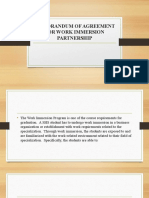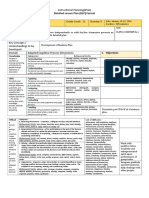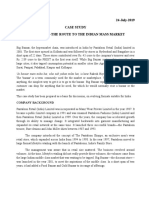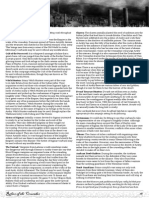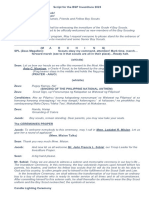Instructional Planning (Iplan) : Detailed Lesson Plan (DLP) Format
Instructional Planning (Iplan) : Detailed Lesson Plan (DLP) Format
Uploaded by
Reynalyn HernandezCopyright:
Available Formats
Instructional Planning (Iplan) : Detailed Lesson Plan (DLP) Format
Instructional Planning (Iplan) : Detailed Lesson Plan (DLP) Format
Uploaded by
Reynalyn HernandezOriginal Description:
Original Title
Copyright
Available Formats
Share this document
Did you find this document useful?
Is this content inappropriate?
Copyright:
Available Formats
Instructional Planning (Iplan) : Detailed Lesson Plan (DLP) Format
Instructional Planning (Iplan) : Detailed Lesson Plan (DLP) Format
Uploaded by
Reynalyn HernandezCopyright:
Available Formats
Instructional Planning(iPlan)
Detailed Lesson Plan (DLP) Format
DLP No.:07 Learning Area: Grade Level: 11 Quarter:3 Date: January 16-19, 2016
Entrepreneurship Duration: 240 minutes
Code:
Learning
Competency/ies:
(Taken from the Curriculum Guide) Develop a brand name CS_EP11/12ENTREP-0h-j-
11
Key Concepts /
Branding
Understandings to be
Developed
Domain Adapted Cognitive Process Dimensions 1. Objectives
Knowledge Categories: Behavioral Verbs:
The fact or Remembering identify, retrieve, recognize, duplicate,
condition of list, memorize, repeat, describe,
The learner can recall information and Identify the commonly used
knowing something retrieve relevant knowledge from long-term reproduce
with familiarity branding strategy
memory
gained through
experience or
Understanding interpret, exemplify, classify,
The learner can construct meaning from oral, summarize, infer, compare, explain,
association paraphrase, discuss
written and graphic messages
Skills Applying execute, implement, demonstrate,
The ability and The learner can use information to dramatize, interpret, solve, use,
capacity acquired undertake a procedure in familiar situations illustrate, convert, discover
through deliberate, or in a new way
systematic, and Analyzing differentiate, distinguish, compare,
sustained effort to The learner can distinguish between parts contrast, organize, outline, attribute,
smoothly and and determine how they relate to one deconstruct
adaptively carryout another, and to the overall structure and
complex activities or purpose
... the ability,
coming from one's
Evaluating coordinate, measure, detect, defend,
The learner can make judgments and justify judge, argue, debate, describe, critique,
knowledge, appraise, evaluate
practice, aptitude, decisions
etc., to do Creating generate, hypothesize, plan, design,
something The learner can put elements together to develop, produce, construct, formulate, Formulate own brand extension
form a functional whole, create a new assemble, devise strategy.
product or point of view
Attitude Categories: List of Attitudes:
Growth in 1. Receiving Phenomena - Awareness, willingness to hear, selected attention Self-esteem, Self-confidence, Wellness,
feelings or Behavioral Verbs: ask, choose, describe, erect, follow, give, hold, Respect, Honesty, Personal discipline,
emotional identify, locate, name, point to, reply, select, sit, Study, use Perseverance, Sincerity, Patience,
areas. 2. Responding to Phenomena - Active participation on the part of the Critical thinking, Open-mindedness,
A settled learners. Attends and reacts to a particular phenomenon. Learning Interest, Courteous, Obedience, Hope,
way of outcomes may emphasize compliance in responding, willingness to Charity, Fortitude, Resiliency, Positive
thinking or respond, or satisfaction in responding (motivation). vision, Acceptance, Determined,
feeling about Behavioral Verbs: aid, answer, assist, comply, conform, discuss, greet, Independent , Gratitude, Tolerant,
someone or help, label, perform, practice, present, read, recite, report, select, tell, write Cautious, Decisive, Self-Control,
something, Calmness, Responsibility,
typically one
3. Valuing - Attaches to a particular object, phenomenon, or behavior. This
Accountability, Industriousness,
Demonstrate
ranges from simple acceptance to the more complex state of solidarity in the
that is commitment. Valuing is based on the internalization of a set of specified Industry, Cooperation, Optimism,
reflected in a values, while clues to these values are expressed in the learner's overt Satisfaction, Persistent, Cheerful, entire
person’s behavior and are often identifiable. Reliable, Gentle, Appreciation of one’s performance of
behavior culture, Globalism, Compassion, Work tasks assigned.
Behavioral Verbs: work, complete, demonstrate, differentiate, explain, Ethics, Creativity, Entrepreneurial Spirit,
follow, form, initiate, invite, join, justify, propose, read, report, select, Financial Literacy, Global, Solidarity,
share, study Making a stand for the good,
4. Organization - Organizes values into priorities by contrasting different Voluntariness of human act,
values, resolving conflicts between them, and creating a unique value Appreciation of one’s rights,
system. The emphasis is on comparing, relating, and synthesizing values. Inclusiveness, Thoughtful, Seriousness,
Behavioral Verbs: adhere, alter, arrange, combine, compare, complete, Generous, Happiness, Modest,
defend, explain, formulate, generalize, identify, integrate, modify, order,
organize, prepare, relate, synthesize
5. Internalizing values - (Characterization): Has a value system that controls Authority, Hardworking, Realistic, Display creativity
their behavior. The behavior is pervasive, consistent, predictable, and most Flexible, Considerate, and decisiveness
importantly, characteristic of the learner. Instructional objectives are Sympathetic, Frankness
concerned with the student's general patterns of adjustment (personal,
in all group
social, emotional). activities to be
performed and
Behavioral Verbs: act, discriminate, display, influence, listen, modify, integrate such
perform, practice, propose, qualify, question, revise, serve, solve, verify values in day to
day tasks.
Values Categories: List of Values:
A learner's 1. Receiving Phenomena - Awareness, willingness to hear, selected 1. Maka-Diyos Demonstrate kindness
principles or attention Love of God, Faith, Trusting , towards other group
standards of Behavioral Verbs: ask, choose, describe, erect, follow, give, hold, Spirituality, Inner Peace, Love of truth, members and
behavior; identify, locate, name, point to, reply, select, sit, Study, use Kindness, Humble classmates.
one's 2. Responding to Phenomena - Active participation on the part of the
2. Maka-tao
judgment of learners. Attends and reacts to a particular phenomenon. Learning
Concern for Others, Respect for human
what is outcomes may emphasize compliance in responding, willingness to respond,
rights, Gender equality, Family
important in or satisfaction in responding (motivation).
Solidarity, Generosity, Helping, Oneness
life. Behavioral Verbs: aid, answer, assist, comply, conform, discuss, greet, 3. Makakalikasan
help, label, perform, practice, present, read, recite, report, select, tell, Care of the environment, Disaster Risk
Go beyond write
learner’s life Management, Protection of the
3. Valuing - Attaches to a particular object, phenomenon, or behavior. This Environment, Responsible
on earth, ranges from simple acceptance to the more complex state of commitment.
include more Consumerism, Cleanliness, Orderliness,
Valuing is based on the internalization of a set of specified values, while Saving the ecosystem, Environmental
than wealth clues to these values are expressed in the learner's overt behavior and are
and fame, sustainability
often identifiable.
and would 4. Makabansa
Behavioral Verbs: work, complete, demonstrate, differentiate, explain, Peace and order, Heroism and Integrate civic
affect the
follow, form, initiate, invite, join, justify, propose, read, report, select, Appreciation of Heroes, National Unity, consciousness
eternal
share, study Civic Consciousness, Social within the group
destiny of
4. Organization - Organizes values into priorities by contrasting different responsibility, Harmony, Patriotism, discussions.
millions
values, resolving conflicts between them, and creating a unique value Productivity
system. The emphasis is on comparing, relating, and synthesizing values.
Behavioral Verbs: adhere, alter, arrange, combine, compare, complete,
defend, explain, formulate, generalize, identify, integrate, modify, order,
organize, prepare, relate, synthesize
5. Internalizing values - (Characterization): Has a value system that controls
their behavior. The behavior is pervasive, consistent, predictable, and most
importantly, characteristic of the learner. Instructional objectives are
concerned with the student's general patterns of adjustment (personal,
social, emotional).
Behavioral Verbs: act, discriminate, display, influence, listen, modify,
perform, practice, propose, qualify, question, revise, serve, solve, verify
2. Content Branding
3.LearningResources Textbook, CG (Entrepreneurship)
4. Procedures
4.1 Introductory Activity ( 15 minutes). This part introduces the lesson content. Differentiate needs from wants.
Although at times optional, it is usually included to serve as a warm-up activity to give the List personal needs and wants. Share list to class.
learners zest for the incoming lesson and an idea about what it to follow. One principle in Answer the question “ Does the degree or level of
learning is that learning occurs when it is conducted in a pleasurable and comfortable
atmosphere.
needs and wants differ among individuals?”
4.2 Activity ( 15 minutes). This is an interactive strategy to elicit learner’s prior learning
experience. It serves as a springboard for new learning. It illustrates the principle that Try to recall Maslow’s Hierarchy of Needs. Draw a
learning starts where the learners are. Carefully structured activities such as individual or triangle and place the levels of the hierarchy of needs
group reflective exercises, group discussion, self-or group assessment, dyadic or triadic
interactions, puzzles, simulations or role-play, cybernetics exercise, gallery walk and the like
on it. Discuss each level to group mates.
may be created. Clear instructions should be considered in this part of the lesson.
4.3 Analysis (10 minutes). Essential questions are included to serve as a guide for the
teacher in clarifying key understandings about the topic at hand. Critical points are organized Answer the questions:
to structure the discussions allowing the learners to maximize interactions and sharing of What comes to your mind when you hear the word
ideas and opinions about expected issues. Affective questions are included to elicit the “toothpaste?” How about “shampoo?”
feelings of the learners about the activity or the topic. The last questions or points taken When you are asked to describe a “burger,” what will
should lead the learners to understand the new concepts or skills that are to be presented in you say first? How about “softdrink?”
the next part of the lesson.
4.4 Abstraction ( 120 minutes).This outlines the key concepts, important skills that Product and services are created because of human needs and
should be enhanced, and the proper attitude that should be emphasized. This is organized as wants. The term needs simply refers to the things that the person
a lecturette that summarizes the learning emphasized from the activity, analysis and new must have on order to survive. The term wants refers to the things
inputs in this part of the lesson. that the person must have in order to be satisfied.
Identify and discuss the branding strategies that entrepreneurs
may adopt.
4.5 Application ( 10 minutes).This part is structured to ensure the commitment of the
learners to do something to apply their new learning in their own environment. Discuss the importance of branding in the practice of
entrepreneurship.
4.6 Assessment ( 60 minutes).For the Teacher to: a) Assess whether learning objectives
have been met for a specified duration, b)Remediate and/or enrich with appropriate
strategies as needed, and c) Evaluate whether learning intentions and success criteria have
been met. (Reminder: Formative Assessment may be given before, during, or after the
lesson). Choose any from the Assessment Methods below:
Assessment Method Possible Activities
a) Observation Identify some branding strategies used by large businesses in the
Philippines.
b) Talking to
learners/conferencing
c) Analysis of learner’s Pretend that your entrepreneurial venture has been making
products and selling one product for the past five years. Plan to make
additional three products. These may be in the same
category as the first product or not. What brand extension
strategy are you going to adopt? Indicate your reason for
your decision.
d) Tests End of chapter pencil and paper test.
4.7 Assignment ( 5 minutes).
Reinforcing / strengthening Answer the activity sheets provided.
the day’s lesson
4.8 Concluding Activity ( 5 minutes).
This is usually a brief but affective The keys to brand success are self-definition, transparency, authenticity and
closing activity such as a strong accountability.
quotation, a short song, an anecdote, - Simon Mainwaring
parable or a letter that inspires the
learners to do something to practice
their new learning.
1. Remarks Indicate below special cases including but not limited to continuation of lesson plan to the following day in case of re-teaching or lack of
time, transfer of lesson to the following day, in cases of class suspension, etc.,
3. Reflections Reflect on your teaching and assess yourself as a teacher. Think about your student’s progress this week. What works? What else needs to
be done to help the students learn? Identify what help your instructional supervisors can provide for you so when you meet them, you can
ask them relevant questions. Indicate below whichever is/are appropriate.
A. No. of learners who
earned 80% in the
evaluation.
B. Did the remedial
lessons work? No. of
learners who have
caught up with the
lesson.
C. No. of learners who
require additional
activities for
remediation.
D. Which of my learning
strategies worked
well? Why did these
work?
E. What difficulties did I
encounter which my
principal or
supervisor can help
me solve?
F. What innovation or
localized materials
did I use/discover
which I wish to share
with other teachers?
G.
H.
Prepared by:
Name: Ma. Larity Alburo-Carin School: Carmen National High School - Day
You might also like
- ISBP745 International Standard Banking PracticeDocument74 pagesISBP745 International Standard Banking PracticeMahendar Weezyholic Bist100% (1)
- Pratik - BA Deliverables - Online Loan ApplicationDocument15 pagesPratik - BA Deliverables - Online Loan Applicationpratik pareshNo ratings yet
- Sto. Domingo Integrated School: Weekly Home Learning Plan Practical Research 1Document5 pagesSto. Domingo Integrated School: Weekly Home Learning Plan Practical Research 1Reynalyn HernandezNo ratings yet
- Promises of The Book of Mormon ListDocument17 pagesPromises of The Book of Mormon ListFaveNo ratings yet
- Instructional Planning (Iplan) : Detailed Lesson Plan (DLP) FormatDocument3 pagesInstructional Planning (Iplan) : Detailed Lesson Plan (DLP) FormatReynalyn HernandezNo ratings yet
- Instructional Planning (Iplan) : Detailed Lesson Plan (DLP) FormatDocument3 pagesInstructional Planning (Iplan) : Detailed Lesson Plan (DLP) FormatReynalyn HernandezNo ratings yet
- Instructional Planning (Iplan) : Detailed Lesson Plan (DLP) FormatDocument3 pagesInstructional Planning (Iplan) : Detailed Lesson Plan (DLP) FormatReynalyn HernandezNo ratings yet
- Instructional Planning (Iplan) : Detailed Lesson Plan (DLP) FormatDocument3 pagesInstructional Planning (Iplan) : Detailed Lesson Plan (DLP) FormatReynalyn HernandezNo ratings yet
- Instructional Planning (Iplan) : Detailed Lesson Plan (DLP) FormatDocument3 pagesInstructional Planning (Iplan) : Detailed Lesson Plan (DLP) FormatReynalyn HernandezNo ratings yet
- Instructional Planning (Iplan) : Detailed Lesson Plan (DLP) FormatDocument4 pagesInstructional Planning (Iplan) : Detailed Lesson Plan (DLP) FormatReynalyn HernandezNo ratings yet
- Instructional Planning (Iplan) : Detailed Lesson Plan (DLP) FormatDocument3 pagesInstructional Planning (Iplan) : Detailed Lesson Plan (DLP) FormatReynalyn HernandezNo ratings yet
- Instructional Planning (Iplan) : Detailed Lesson Plan (DLP) FormatDocument3 pagesInstructional Planning (Iplan) : Detailed Lesson Plan (DLP) FormatReynalyn HernandezNo ratings yet
- EntrepreneurshipHandout Week 5Document6 pagesEntrepreneurshipHandout Week 5Pio GuiretNo ratings yet
- Sdo Batangas: Department of EducationDocument4 pagesSdo Batangas: Department of EducationKimberly Solomon JavierNo ratings yet
- Things To Do Guidelines RemindersDocument4 pagesThings To Do Guidelines RemindersJONAS SIBALNo ratings yet
- Student Training Agreement and Liability Waiver: Document No.: CCS-OJT-04-03 Effective Date: July 28, 2017Document3 pagesStudent Training Agreement and Liability Waiver: Document No.: CCS-OJT-04-03 Effective Date: July 28, 2017Kuku LNo ratings yet
- Trade Show Booth MechanicsDocument2 pagesTrade Show Booth MechanicsNicole LarizaNo ratings yet
- SHS DLL Week 1Document4 pagesSHS DLL Week 1Rd David100% (1)
- Cert AppearanceDocument1 pageCert AppearanceJig Pael FaburadaNo ratings yet
- Sample Draft For Thesis WritingDocument32 pagesSample Draft For Thesis WritingEunice DemataNo ratings yet
- 06 - Student Training Agreement and Liability Waiver FormDocument2 pages06 - Student Training Agreement and Liability Waiver FormRFSNo ratings yet
- Entrep Q2 M7Document18 pagesEntrep Q2 M7Ahrcelie Francisco100% (1)
- Feasibility Study Standar Format UpdatedDocument37 pagesFeasibility Study Standar Format UpdatedrblorenzanaNo ratings yet
- FINAL Feasibility Study Business Plan Group 2 HTRM 3 1Document76 pagesFINAL Feasibility Study Business Plan Group 2 HTRM 3 1Estela Marie MontanoNo ratings yet
- Title Defense GuidelinesDocument2 pagesTitle Defense GuidelinesDhona Mae FidelNo ratings yet
- BUSINESS PLAN Guide QuestionsDocument3 pagesBUSINESS PLAN Guide QuestionsJunar MerlaNo ratings yet
- Qualitative Research-Review-GuideDocument5 pagesQualitative Research-Review-GuideEnitsirk SañitNo ratings yet
- Group Assessment FormDocument1 pageGroup Assessment Formbadiem10% (1)
- Unit 3 - Lesson 1Document70 pagesUnit 3 - Lesson 1Mary Rose Caspe PicardalNo ratings yet
- SeniorhighimmersionDocument21 pagesSeniorhighimmersionElleiram ArellanoNo ratings yet
- 07 - RES03 - Alternative For MoA Work Immersion Agreement Form - SY2223Document1 page07 - RES03 - Alternative For MoA Work Immersion Agreement Form - SY2223RFSNo ratings yet
- Payslip - FormatDocument2 pagesPayslip - Formathemantfauzdar75% (4)
- Entrep Q2 M1Document13 pagesEntrep Q2 M1Aglahian Mark RedenNo ratings yet
- 3 - Work Immersion Agreement FormDocument1 page3 - Work Immersion Agreement FormLeshwa MendigroyaNo ratings yet
- Criteria For Product ProposalDocument3 pagesCriteria For Product ProposalChristine CastroNo ratings yet
- Gifted To Give": 400 Year OAR Presence in The Island of Cebu & Year of St. Joseph, The Husband of MaryDocument2 pagesGifted To Give": 400 Year OAR Presence in The Island of Cebu & Year of St. Joseph, The Husband of MaryHARLEY L. TANNo ratings yet
- Department of Education: Republic of The PhilippinesDocument3 pagesDepartment of Education: Republic of The PhilippinesJoy Angara BuenconsejoNo ratings yet
- Chapter 11 Social Relationship Middle and Late AdolescenceDocument14 pagesChapter 11 Social Relationship Middle and Late AdolescenceJonar MarieNo ratings yet
- Research in Daily Life 1: Qualitative Research Designs, Sample, and Data Collection and Analysis ProceduresDocument14 pagesResearch in Daily Life 1: Qualitative Research Designs, Sample, and Data Collection and Analysis ProceduresAnya LiggayuNo ratings yet
- DLP Entrep2 Dec 2-5, 2019Document2 pagesDLP Entrep2 Dec 2-5, 2019Marlon CacaNo ratings yet
- Work Emersion MOADocument26 pagesWork Emersion MOAEsmeraldo FulgarNo ratings yet
- Format For Title ProposalDocument5 pagesFormat For Title Proposalzaldy mendozaNo ratings yet
- Diagnostic - EntrepreneurshipDocument6 pagesDiagnostic - EntrepreneurshipKim Pecenio MoralidadNo ratings yet
- 2019 St. Mary's Shopping Expo RegistrationDocument1 page2019 St. Mary's Shopping Expo RegistrationTricia WitkemperNo ratings yet
- DLL Applied EntrepreneurshipDocument70 pagesDLL Applied EntrepreneurshipRuby Celeste Ejedo FranciscoNo ratings yet
- Entrep 1ST QuarterDocument59 pagesEntrep 1ST QuarterRoNnie RonNieNo ratings yet
- Budget of Work PR2 2022 2023Document2 pagesBudget of Work PR2 2022 2023Frances Margarett DomingoNo ratings yet
- GRADES 1 To 12 Daily Lesson Log Monday Tuesday Wednesday Thursday FridayDocument6 pagesGRADES 1 To 12 Daily Lesson Log Monday Tuesday Wednesday Thursday Fridayphebe tragicoNo ratings yet
- Work Immersion PlanDocument4 pagesWork Immersion PlanMoises Von Rosauro De GraciaNo ratings yet
- PR2 DLL - Week 2Document5 pagesPR2 DLL - Week 2nedieNo ratings yet
- PR 2 - Handouts (WK 1-3)Document4 pagesPR 2 - Handouts (WK 1-3)Alrose HolgadoNo ratings yet
- Building Experience. Shaping The FutureDocument5 pagesBuilding Experience. Shaping The FuturejoelNo ratings yet
- DLL CO2 ELIC May16Document5 pagesDLL CO2 ELIC May16Marivie Da-arol ElicNo ratings yet
- Senior High School Parents OrientationDocument26 pagesSenior High School Parents OrientationSuzanne Carollo VillabarbasNo ratings yet
- Las Work ImmersionDocument5 pagesLas Work ImmersionLourdes UrgellesNo ratings yet
- 04 Task Performance 1Document2 pages04 Task Performance 1Flordaline DonayreNo ratings yet
- Brand Attachment: Affecting Factors and ConsequencesDocument8 pagesBrand Attachment: Affecting Factors and ConsequencesManish AroraNo ratings yet
- Epowerment Technologies12 - LM1 2Document18 pagesEpowerment Technologies12 - LM1 2ruclito morataNo ratings yet
- Learning Activity Sheet No. 5 Practical Research 1: Jose C. Prevosa Sr. National High SchoolDocument3 pagesLearning Activity Sheet No. 5 Practical Research 1: Jose C. Prevosa Sr. National High SchoolBen A MalanyaonNo ratings yet
- Module 2 Pr2 1st QuarterDocument5 pagesModule 2 Pr2 1st QuarterJelsie BastawangNo ratings yet
- Understanding The 7ps of The Marketing MixDocument32 pagesUnderstanding The 7ps of The Marketing MixLauren Frea N HerreraNo ratings yet
- Rubric For Final Proposal DefenseDocument2 pagesRubric For Final Proposal DefenseJohn MichaelNo ratings yet
- WorkSheet 2.1 - 2.5Document10 pagesWorkSheet 2.1 - 2.5Christian Paul ExaminaNo ratings yet
- Ent 28ADocument3 pagesEnt 28AJeanne AndradeNo ratings yet
- Research Design For Qualitative Research: ExampleDocument2 pagesResearch Design For Qualitative Research: ExampleReynalyn HernandezNo ratings yet
- Week Speech ActsDocument15 pagesWeek Speech ActsReynalyn HernandezNo ratings yet
- Engineering, Law and NursingDocument2 pagesEngineering, Law and NursingReynalyn HernandezNo ratings yet
- Instructional Planning (Iplan) : Detailed Lesson Plan (DLP) FormatDocument3 pagesInstructional Planning (Iplan) : Detailed Lesson Plan (DLP) FormatReynalyn HernandezNo ratings yet
- Instructional Planning (Iplan) : Detailed Lesson Plan (DLP) FormatDocument4 pagesInstructional Planning (Iplan) : Detailed Lesson Plan (DLP) FormatReynalyn HernandezNo ratings yet
- Professional Writing Strategies For Con StudentsDocument38 pagesProfessional Writing Strategies For Con StudentsReynalyn HernandezNo ratings yet
- Detailed Lesson Plan (DLP) : Learning AreaDocument4 pagesDetailed Lesson Plan (DLP) : Learning AreaReynalyn HernandezNo ratings yet
- Instructional Planning (Iplan) : Detailed Lesson Plan (DLP) FormatDocument3 pagesInstructional Planning (Iplan) : Detailed Lesson Plan (DLP) FormatReynalyn HernandezNo ratings yet
- Grade 12 - TVL AUGUST 14-15, 2017 Practical Research 2 10:45 - 11:45 A.M. First 2 HrsDocument5 pagesGrade 12 - TVL AUGUST 14-15, 2017 Practical Research 2 10:45 - 11:45 A.M. First 2 HrsReynalyn HernandezNo ratings yet
- Instructional Planning (Iplan) : Detailed Lesson Plan (DLP) FormatDocument3 pagesInstructional Planning (Iplan) : Detailed Lesson Plan (DLP) FormatReynalyn HernandezNo ratings yet
- Pr2 DLPDocument4 pagesPr2 DLPReynalyn HernandezNo ratings yet
- Detailed Lesson Plan (DLP) Format: Instructional PlanningDocument5 pagesDetailed Lesson Plan (DLP) Format: Instructional PlanningReynalyn HernandezNo ratings yet
- Detailed Lesson Plan (DLP) Format: Instructional PlanningDocument4 pagesDetailed Lesson Plan (DLP) Format: Instructional PlanningReynalyn HernandezNo ratings yet
- Detailed Lesson Plan (DLP) Format: Instructional PlanningDocument2 pagesDetailed Lesson Plan (DLP) Format: Instructional PlanningReynalyn HernandezNo ratings yet
- Detailed Lesson Plan (DLP) Format: Instructional PlanningDocument10 pagesDetailed Lesson Plan (DLP) Format: Instructional PlanningReynalyn HernandezNo ratings yet
- Detailed Lesson Plan (DLP) Format: Instructional PlanningDocument2 pagesDetailed Lesson Plan (DLP) Format: Instructional PlanningReynalyn HernandezNo ratings yet
- La Gard Product Bulletin 31Document1 pageLa Gard Product Bulletin 31rickyjamesNo ratings yet
- Documentary Analysis OutlineDocument3 pagesDocumentary Analysis OutlineNicole MangibinNo ratings yet
- Avanti SwaminDocument9 pagesAvanti SwaminSadagopan IyengarNo ratings yet
- Question Paper IDocument15 pagesQuestion Paper IBk VikrantNo ratings yet
- National Innovation and Startup Policy (Nisp) For Students and Faculty in HeisDocument18 pagesNational Innovation and Startup Policy (Nisp) For Students and Faculty in HeisamitcmsNo ratings yet
- Lim v. Moldex Land Inc. Lim v. Moldex Land Inc.: I. Facts of The Case III. HeldDocument2 pagesLim v. Moldex Land Inc. Lim v. Moldex Land Inc.: I. Facts of The Case III. HeldChristine SumawayNo ratings yet
- Cougar Dating PDFDocument64 pagesCougar Dating PDFwebdesigned100% (2)
- Sampoorna Raksha Supreme (SRS) Brochure V4Document10 pagesSampoorna Raksha Supreme (SRS) Brochure V4tsonsare1410No ratings yet
- Spoiler Kit Alter v1.0Document8 pagesSpoiler Kit Alter v1.0tu neko uwuNo ratings yet
- American Sociological Association Is Collaborating With JSTOR To Digitize, Preserve and Extend Access To American Sociological ReviewDocument22 pagesAmerican Sociological Association Is Collaborating With JSTOR To Digitize, Preserve and Extend Access To American Sociological ReviewDaryl ⎝⏜⏝⏜⎠ RocoNo ratings yet
- I. Use The Correct Tense-Forms of The Verbs in Brackets.: Diagnostic Test # 1Document11 pagesI. Use The Correct Tense-Forms of The Verbs in Brackets.: Diagnostic Test # 1Валентина Василівна БанилевськаNo ratings yet
- BIG BAZAAR Case StudyDocument8 pagesBIG BAZAAR Case StudyDev MaanNo ratings yet
- Fanatic Magazine 27Document16 pagesFanatic Magazine 27Psygnosis ReddevilsNo ratings yet
- Wise Money PDFDocument20 pagesWise Money PDFUltimate MasterzNo ratings yet
- Definitions of Capital Assets and Ordinary AssetsDocument1 pageDefinitions of Capital Assets and Ordinary AssetsJedy Ann PamorNo ratings yet
- BSP Script 2023 2024Document4 pagesBSP Script 2023 2024Uy HenryNo ratings yet
- Mastery SummaryDocument9 pagesMastery Summarylaikienfui0% (3)
- Oldenburg Third PlacesDocument5 pagesOldenburg Third Placesud.armalvikaNo ratings yet
- Company Profile PrestigeDocument3 pagesCompany Profile PrestigeAl Vincent Ma Gantinao DelgadoNo ratings yet
- 46 Emergency Motion For Release From CustodyDocument5 pages46 Emergency Motion For Release From CustodyJake OffenhartzNo ratings yet
- What Is Novel.Document79 pagesWhat Is Novel.bariscem100% (1)
- Maintenance PlanningDocument2 pagesMaintenance PlanningDon - BIN95.comNo ratings yet
- India CW CAT 1Document88 pagesIndia CW CAT 1AAKASH GOPALNo ratings yet
- HR Analytics CA1 Individual Report - Hong Zi XuanDocument6 pagesHR Analytics CA1 Individual Report - Hong Zi XuanamrithaNo ratings yet
- The Audit of Wages - Students - ACCA - ACCA GlobalDocument9 pagesThe Audit of Wages - Students - ACCA - ACCA Globaldesk.back.recovNo ratings yet
- Locomotive Survey Clean Diesel TechnologyDocument73 pagesLocomotive Survey Clean Diesel TechnologyNoLifeNo ratings yet
- Stories QXDDocument5 pagesStories QXDsitu sharmaNo ratings yet








































